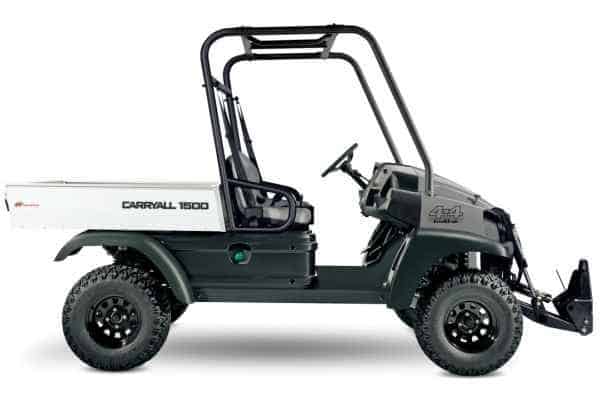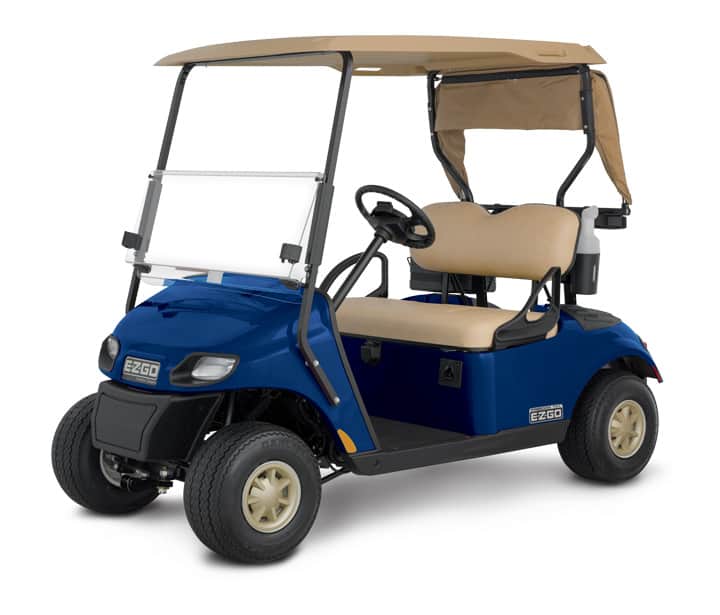How Does a Golf Cart Work
In the most basic sense, your electric golf cart works by providing electric power from a battery pack to a motor that turns your wheels. Everything else involved is just a way of controlling when and how much of that power is being delivered. The battery pack is pretty basic. It could be anywhere from 6 to 48 volts, but it’s usually 36 or 48 volts on most newer electric golf carts.
The battery pack’s power is routed to the motor, but along the way, it is changed by a solenoid and a speed controller to give you only the power you’re asking for and only when you’re asking for it. The solenoid is basically a switch. Like a light switch, it just turns on the power when you press your pedal, and turns it off after you release the pedal.
The speed controller is a little more complex, but it varies the amount of power going to your motor based on how far down you push the pedal. We’ll talk about all of these electric golf cart components in more depth, but we’re gonna start with the battery.
Electric golf cart battery pack
Your electric golf cart batteries are what introduce the electrical energy to make your golf cart go. Batteries work by changing chemical energy into electrical energy. Different types of batteries use different types of chemical reactions to do this, but for the most part they’re all very similar. We did a whole article on golf cart batteries if you want to know more, but for this article you just need to know that some acid and some metal are reacting in a way that creates electrical energy.
Eventually the chemical reaction will equalize, and at this point you have discharged your battery. When you charge it, you’re actually just recreating the conditions for this chemical reaction. Over time, through wear and a process called sulfation, you’ll get less and less chemical reaction when you charge the batteries, and eventually they’ll require replacement.
The battery is a pretty simple component, but obviously it is one of the most important since without the battery you have no electrical energy.

of Callaway ERC Triple
Track Golf Balls for
yourself or your buddy!
Golf cart solenoid
Your batteries change chemical energy into electrical energy, then send it to the motor through cables, but if the electricity was full blast all the time, you’d have one crazy ride. For this reason, you have a solenoid and a speed controller. We did a write up on golf cart solenoids if you want to get deeper knowledge, or learn how to test them. Like I said before, a solenoid is basically a switch, but more specifically, it’s a relay, meaning that it’s a switch that uses one circuit to control another.
In the case of your electric golf cart solenoid, it uses a circuit activated by your accelerator to control whether or not the motor receives power from the batteries. Makes sense, right? You push the pedal down, and the solenoid turns on the circuit that sends power to the motor.
Just imagine if those were your only choices. Full on power or full stop, with no in between. It would be fun for a few hard starts, but honestly you need the ability to control your speed. That’s where the electric golf cart speed controller comes in.
Electric golf cart speed controller
Most people have a general idea of how a gas engine works, you push the pedal down, the throttle opens up, and the engine receives more air and fuel allowing it to go faster.
Unfortunately for electric golf carts, electricity can’t just be throttled or dripped in the same way air and fuel can. No matter how hard you pinch a cable, it’ll still send the same amount of electricity.
Because of this, the people that made your electric golf cart had to come up with a different speed control system. It works by having a component in the motor circuit that uses electric resistance to create a voltage drop.
Basically it consumes electric energy that would otherwise go to the golf cart’s motor, thus allowing you to control the motor’s speed. This is called a speed controller. Not a very clever name, but very descriptive.
The speed controller is essentially a variable resistor. You have them in most electrical systems. They’re a pretty simple concept. Depending on some type of input, the variable resistor will consume different amounts of energy. In the case of your golf cart speed controller, the input is the signal from your accelerator pedal.
This signal will tell the speed controller to turn on full blast as the pedal is first pressed. Most of the electrical energy is then consumed at the speed controller, making the motor move rather slowly. As you press the accelerator further down, the signal tells the speed controller to use less energy, allowing more and more to go to the motor, which in turn means you go faster.

and apparel.
gear, accessories and apparel. (affiliate link)
Electric golf cart throttle
So you may have noticed that both the solenoid and speed controller are controlled by the accelerator. This makes sense, because most vehicles you’ve ever driven had a gas pedal, right? The gas pedal was connected to a cable that would open up a throttle that allowed more air and fuel into the engine. It’s a pretty simple concept.
Your electric golf cart “gas pedal” obviously doesn’t control gas flow into your engine, but the way it works isn’t entirely dissimilar. It’s called an inductive throttle sensor. What that really means is when you push down your electric golf cart accelerator, you’re actually pushing a rod through an inductive sensor coil.
The sensor coil uses this to tell the speed controller how much voltage to consume. So the more you press the pedal down, the more power is sent to your motor. Make sense?
Electric golf cart motor
Now that your battery’s voltage has made it through the series of trials, it finally finds it self feeding the motor. Electric motors have been around for a couple hundred years, and honestly after around the 1890s, not a whole lot has changed. We got better at building them and eeking out efficiency, but in truth, the design is essentially the same.
A DC motor is the most basic, and a lot of entry level golf carts still use them. They can easily reach the speed demands of fleet golf carts, and are a lot cheaper to manufacture. A DC motor consists of three parts: a stator, rotor, and commutator. The stator is the part of the motor that stays still, usually the outside part, and typically made out of copper windings.
On most DC motors, it provides the electromagnetic field that makes the motor move. The part that is moving is called the rotor. It’s essentially a rod wrapped in copper wire that reacts to the electromagnetic forces in the stator.
With only those two parts, the rotor would find the attractant pole of the stator, and then the motor would stop. That’s what the commutator is for. The most basic design of a commutator is a pair of brushes that transfer power to the plates on the stator.
This consistently reverses the stator’s magnetic polarity, thus powering the motor’s movement. Most DC motors have a few pairs of brushes to create multiple overlapping electromagnetic fields to increase the mechanical power output of the motor.
Interestingly, when mechanical power is used to turn the rotor on these engines, it converts it into electrical power which is how most generators work.
AC motors are swiftly on the come up in the golf cart world. They are only a little more expensive (~$500), but drastically increase battery range and power while reducing maintenance costs. Of course, batteries only put out DC power, so for an electric golf cart to use an AC motor, it has to convert the power. This is usually done in the speed controller.
The conversion will create a three wave AC signal. This basically means that there are three separate pulse waves that are specifically timed to reverse polarity on the stator similar to the brushes on a DC motor. It seems more complicated, but it really isn’t. The plus side is that it uses the battery voltage much more efficiently.
This means it can be more powerful and have a longer range. Neat!
Armed with this knowledge, it should be much easier to perform maintenance or increase power and speed on your electric golf cart. Good luck, and happy trails!







